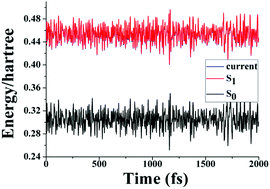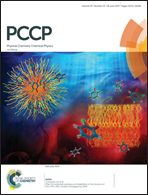The influence of hydrogen bonds on NIAD-4 for use in the optical imaging of amyloid fibrils†
Abstract
The fast and accurate detection of amyloid fibrils, which are associated with many neurodegenerative diseases, is important for their early diagnosis. {[50-(p-Hydroxyphenyl)-2,20-bithienyl-5-yl]-methylidene}-propanedinitrile (NIAD-4) is a new promising fluorescent marker for amyloid fibrils, and the photophysical behaviour of NIAD-4 is controversial. Nonadiabatic dynamic simulations, density functional theory (DFT) and time-dependent density functional theory (TDDFT) calculations were performed to determine the influence of the environment on NIAD-4 and the photophysical behaviour of NIAD-4. The results indicate that NIAD-4 is in the NIAD-4·3H2O compound form in the ground state in water. The torsion process of NIAD-4 proposed by Hu et al. (Phys. Chem. Chem. Phys. 2016, 18, 28) does not occur in the excited state. In addition, the fluorescence behaviour of NIAD-4 is sensitive to a hydrogen bonding environment, the maximum fluorescence wavelengths of NIAD-4 show considerable red-shifts, and the fluorescence intensity of NIAD-4 increases significantly in a hydrogen bonding environment. Intermolecular hydrogen bonds are vital for the phenomenon observed in the experiment because the fluorescence intensity of NIAD-4 becomes unusually high with increasing solvent polarities. Therefore, the influence of the intermolecular hydrogen bond should be carefully taken into consideration when NIAD-4 is used to probe the amyloid fibrils in hydrogen-bonding surroundings, especially in complex bioenvironments.



 Please wait while we load your content...
Please wait while we load your content...